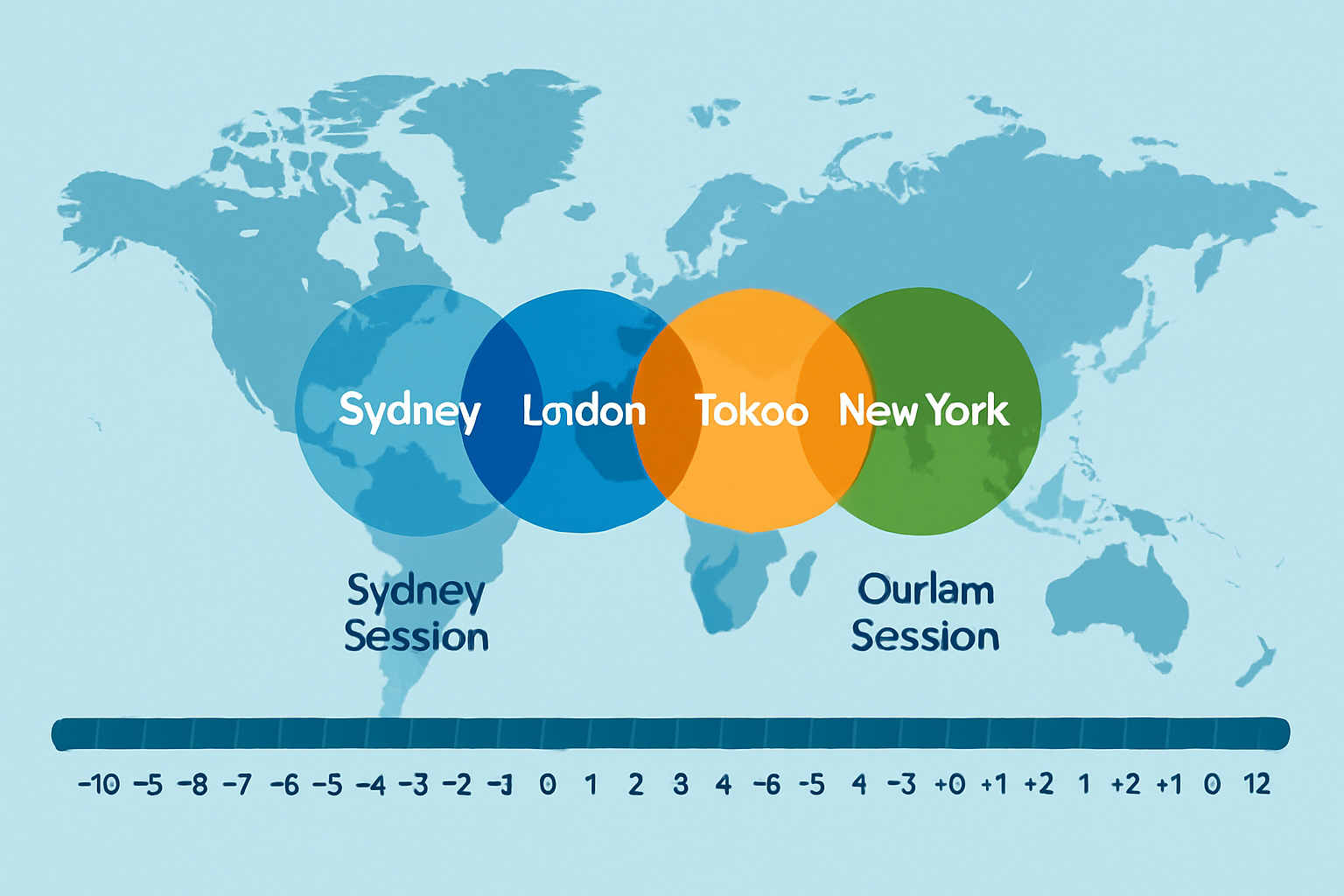
The Jordanian Dinar's Role in the Middle East
Discover how the Jordanian dinar anchors Jordan’s economy and regional trade. This article breaks do...

Knowing the forex market hours is a big deal for traders because it directly impacts liquidity and volatility and how effective their trading strategies turn out at different points in the day.
The forex market never really sleeps and runs 24 hours a day for five days a week thanks to financial centers across various time zones.
Forex market hours are the windows of opportunity when traders jump in to buy, sell and trade currencies across the globe.
Each major session has its own unique trading quirks. The Sydney session kicks off the day with steady and reliable activity and sets the tone. Then Tokyo steps into the spotlight and brings a noticeable uptick as Asian markets join the party. London usually steals the show as the most liquid session and bustles with action.
| Session | Local Hours | GMT/UTC Hours | Key Financial Centers | Typical Market Behavior |
|---|---|---|---|---|
| Sydney | 10:00 PM - 7:00 AM | 9:00 PM - 6:00 AM | Sydney, Wellington | Usually sees low to moderate volume, gently easing into the day |
| Tokyo | 12:00 AM - 9:00 AM | 11:00 PM - 8:00 AM | Tokyo, Hong Kong | Trading volume starts picking up, with Asian currencies taking center stage |
| London | 8:00 AM - 5:00 PM | 7:00 AM - 4:00 PM | London, Frankfurt | Brings the highest liquidity and often turns quite lively |
| New York | 1:00 PM - 10:00 PM | 12:00 PM - 9:00 PM | New York, Chicago | Known for strong volatility, often stirred up by the US dollar and major news events |
Liquidity and volatility ebb and flow throughout the trading day, often taking their cues from the opening and closing of the major sessions. Traders who get a solid handle on these rhythms tend to pick smarter entry and exit points and manage risk more effectively in the ever-shifting market landscape.
The London-New York overlap really tends to steal the spotlight since it merges the liquidity from the two biggest forex hubs, turning it into the busiest trading window of the day.

Visual representation of global forex market sessions and their overlapping hours
Whether you are a seasoned trader or just dipping your toes in, understanding Forex market hours across the globe—and their corresponding time zones—can feel like cracking a secret code. But hang in there; once the pieces fall into place, it’s easier than you might think to catch the right wave and ride it to your advantage.
Knowing how local times sync up with global time zones is a key piece of the puzzle in successful forex trading. Those seasonal tweaks from Daylight Saving Time tend to shake things up a bit, shifting market hours around.
| Time Zone | Sydney Session (Local) | London Session (Local) | New York Session (Local) | Note on DST |
|---|---|---|---|---|
| EST | 5:00 PM - 2:00 AM | 3:00 AM - 12:00 PM | 8:00 AM - 5:00 PM | Eastern Standard and Daylight Time can shake things up a bit here |
| GMT | 10:00 PM - 7:00 AM | 8:00 AM - 5:00 PM | 1:00 PM - 10:00 PM | GMT keeps its cool and stays the same, no matter what DST decides |
| CET | 11:00 PM - 8:00 AM | 9:00 AM - 6:00 PM | 2:00 PM - 11:00 PM | Central European Time likes to switch things up with Daylight Saving adjustments |
| JST | 7:00 AM - 4:00 PM | 5:00 PM - 2:00 AM | 10:00 PM - 7:00 AM | Japan plays it steady, no Daylight Saving here at all |
| AEST | 9:00 AM - 6:00 PM | 7:00 PM - 4:00 AM | 12:00 AM - 9:00 AM | Australian Eastern Standard and Daylight Time are right on schedule here |
Dodge those annoying mix-ups and missed opportunities with online forex market hours converters and calendars. These handy tools automatically adjust to your local timezone and give you a nudge when sessions kick off or wrap up, along with heads-ups on key economic events.
Trading usually hits its sweet spot during those overlapping sessions, because that is when liquidity tends to surge and price movements get a bit livelier. It’s these windows that often serve up the best chances to trade smartly.
Pinpoint the trading sessions that really get things moving for the currency pairs you are focusing on. These are your prime windows.
Keep an eye on the overlaps between sessions like London and New York or Tokyo and London because that is usually when the market throws the most punches.
Pay attention to how wild those currency pairs can get during these times. It will help you plan your trades smarter, not just harder.
Do not forget to check when big economic news is dropping. Timing your trades around these events can save you from some nasty surprises.
A trader working with EUR/USD often times their trades around the London-New York overlap, hoping to catch those tighter spreads and quick price moves sparked by US economic data—it's like catching the market when it’s wide awake and buzzing. Meanwhile, trading USD/JPY pairs usually flow better during the Tokyo and New York sessions—these windows just seem to have a rhythm all their own. A lot of seasoned traders swear by advanced charting platforms like TradingView or TrendSpider, using them to backtest their strategies specifically for these session overlaps.
Currency pairs tend to get livelier during the business hours of their home turf. This regional rhythm plays a big role in shaping predictability, volatility and liquidity as the trading day unfolds.
For traders, fine-tuning strategies to fit these patterns usually pays off handsomely. Scalping USD/JPY tends to shine during the Tokyo morning hours while swing trading GBP/USD often hits its stride when London and New York sessions overlap. Getting a good feel for each session's behavior can be a game-changer. It’s key for deciding when to jump in, managing risk smartly and picking the right analytical tools to have in your corner.
Successful forex trading often comes down to tweaking your approach depending on the forex market hours. When volatility is low, leaning on limit orders can be a smart way to keep slippage in check. During bursts of high volatility, you will usually want to tighten up your risk controls.
"When your trading plan lines up nicely with forex market hours, you’ll often find yourself better at managing risk and catching those golden opportunities in this constantly shifting market." – Experienced Forex Analyst
Dive in and let us clear up some of the common head-scratchers that come with navigating the forex market's quirky schedule.
Struggling to improve your trading performance? Edgewonk's advanced analytics tools are designed to give you the edge you need.
With detailed trade journaling, robust strategy analysis, and psychological insights, you'll gain a comprehensive understanding of your strengths and weaknesses. Don't miss out on this game-changing opportunity.
Traders, it's time to elevate your game. Edgewonk is the ultimate trading journal software designed to empower you with data-driven insights and personalized strategies. Take control of your trading journey and maximize your potential.
17 posts written
Driven by her passion for empowering individual traders, Annika Eriksson is a renowned educator, offering practical strategies and actionable insights for successful trading.
Read Articles
Discover how the Jordanian dinar anchors Jordan’s economy and regional trade. This article breaks do...

Understanding pip values is vital for forex traders. Discover how a free forex pip calculator can si...

Discover the ins and outs of currency market opening hours, their global structure, and how masterin...

Understand the key drivers behind Myanmar currency fluctuations in forex trading, from domestic refo...
